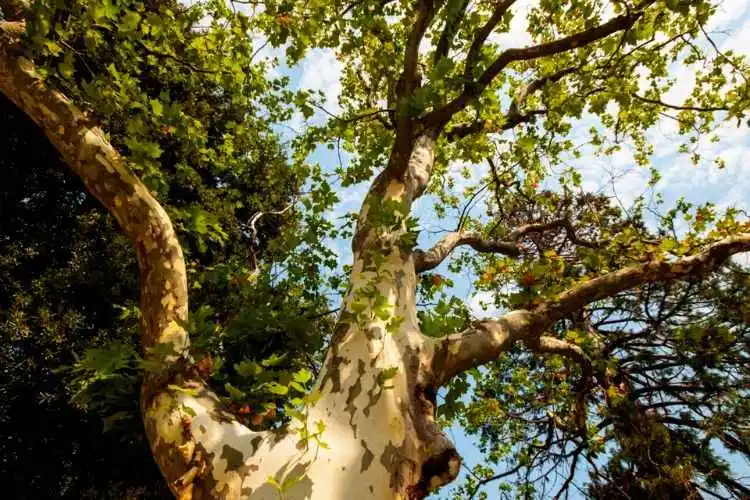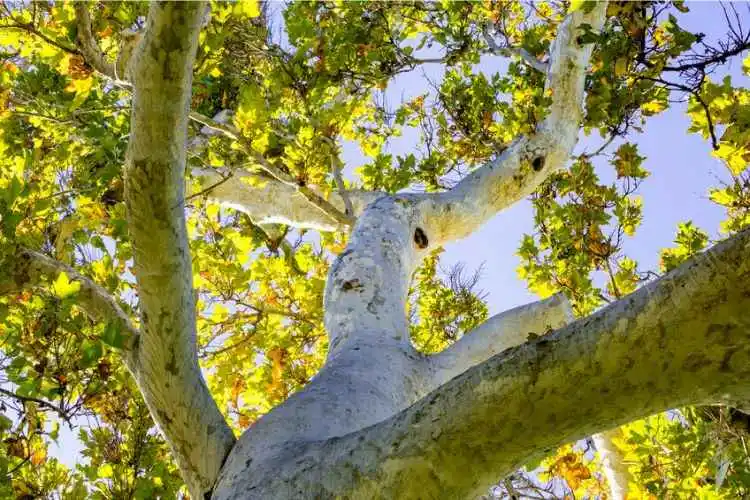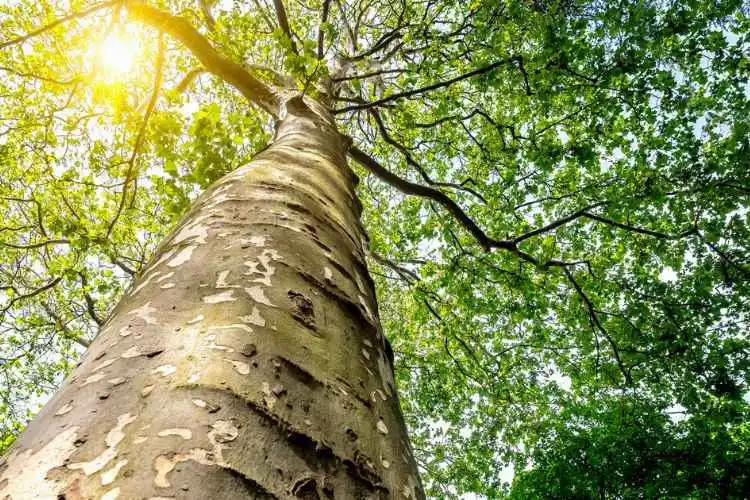There are many different factors to consider while choosing the perfect firewood. One major factor among them is the type of wood and its particular characteristics. The most important quality to look for in firewood is its density and water content. The denser and drier the firewood, the better it is for burning and producing heat.

Another characteristic that makes good firewood is its pitch or sap level that provides longer burn time. So, while looking for good firewood, these are the qualities that you must look for. Now let’s see which of these characteristics Sycamore firewood has and how they contribute towards sealing its fate as firewood.
Is Sycamore Good for Firewood?
Ideally speaking, sycamore firewood is of relatively poor quality. For, even if it’s great for starting fires, it isn’t the best burning for a long time. However, to best determine whether Sycamore is good for firewood, we need to analyze its characters first.
Characteristics of Sycamore as Firewood
Here are some characteristics of the sycamore that are crucial for its role as firewood:

Density and Weight
Sycamore has a density of around 400-600 kg/m3, which is comparatively lower than that of the woods, which are ideal for firewood. Also, its weight per cord is around 5000 lbs, which isn’t considered ideal for good quality firewood.
But it doesn’t render Sycamore entirely useless as firewood, though. Even if it can’t keep you warm for long hours, Sycamore can still be used for purposes that don’t require too much heat or long burning time.
Heat Output
Sycamore initially produces a considerable amount of heat, but it dies down soon because of its high moisture content. For the same reason, Sycamore takes a long time to dry out and isn’t easy to light. Its high water content also makes it hard for Sycamore to have a long burn time, lowering its overall heat output. It produces heat for a very short time, which isn’t enough to keep a house warm for long hours.
Burn Time
As already mentioned, Sycamore has a very short burn time because of its high moisture content. It works great to cater to short-time burning needs but isn’t good if you need warmth for a long time. Sycamore won’t burn slowly for a long time, so the heat won’t last for long. This quality doesn’t make it a good choice for heating but only for quick burning purposes.
Splitting and Seasoning
Sycamore is infamous for its splitting and seasoning qualities. The reason can again be attributed to its high moisture content. The knotty, stringy, and twisted wood fibers make it difficult to split. Sometimes the challenge to separating it is so difficult that people use a chainsaw rather than an axe to do the splitting.
As for seasoning, the high moisture content makes it take longer to season. Growing mostly near water sources, Sycamore comes with low density and high moisture that takes 12-24 months to reduce, and it might seem that the wood takes forever to season.
However, this doesn’t mean you can never use Sycamore as firewood. It’s just that Sycamore is relatively poor compared to other firewood, but it can still work.
Sycamore Firewood BTU
BTU measures the heat content of fuels or other energy sources. Firewoodmeasures the amount of energy it holds and hence the amount of heat that can be produced when it’s burned. So, the higher the BTU of wood, the higher the heat produced by that firewood. Sycamore gives a comparatively low BTU of 19.5 million heat per cord.
It’s mostly because of its low density and high moisture content. Having low BTU means Sycamore has a low burning time and can’t produce as much heat as required to maintain the warmth for a long time. The lower BTU of Sycamore also means that it falls short of the good coaling qualities of its competitors.
Pros and Cons of using Sycamore as Firewood
Like everything else, using Sycamore as firewood also has certain pros and cons. By reading them you will have a clear idea about is sycamore good for firewood or not.

Pros
✅ Despite all its shortcomings, Sycamore is still considered a hardwood, which means that it is denser and has higher burn-time and heat-producing quality than softwoods.
✅ Sycamore is resistant to decay; hence, it can be stored for a long time without rotting or suffering any insect infestation.
✅ Sycamore is renowned for producing less smoke than other firewood since it contains less sap which is mostly responsible for producing the smoke while burning.
✅ Due to its low sap content, Sycamore contributes very little towards creosote build-up in the chimneys and saves you from many dangerous situations.
✅ If seasoned properly, Sycamore becomes very easy to light and hence doesn’t keep you waiting for the warmth and ambiance of a roaring fire and lets you enjoy the heat while it lasts.
✅ Unlike other firewood, Sycamore is a good performer in producing minimal sparks and hence is safe against causing any fire hazards.
✅ Sycamore is also the most budget-friendly option for firewood; hence, it doesn’t cost you a fortune to bring some warmth to your life.
Cons
❌ Due to its low density, Sycamore burns faster than other firewood, which means it needs more replenishments than other types of wood.
❌ Its high moisture content makes it difficult to split and season and sometimes even hard to light.
❌ Due to its lower BTU rating, Sycamore produces less heat per pound and, hence, can’t provide you the warmth that other firewood can.
❌ Sycamore cannot produce great coal qualities like other firewood with high BTU.
❌ The campfire-like smell that Sycamore produces while burning isn’t particularly admirable compared to the firewood, which produces a nice fragrance.
❌ Sycamore firewood is a little hard to find since it’s not as widely produced as other kinds of wood.
What is Sycamore Wood Good for?
Even though Sycamore couldn’t earn itself a good name in the firewood department, there are many other areas where it shines its light. Here are a few things that Sycamore wood is good for:

- More often than not, Sycamore trees are planted for ornamental purposes.
- Highly tolerant of air pollution, Sycamore serves to make a good windbreak.
- Sycamore is a prized possession for its contribution to woodworking.
- Sycamore wood is used for making good-quality furniture.
- Many musical instruments are also made of Sycamore wood.
- Sycamore wood also produces good cabinetry, wood flooring, interior trim, parquetry, joinery, tool handles, and the like.
- Sycamore wood is also used for plywood, pulpwood, crates, boxes, pallets, paneling, and other purposes.
- Sycamore wood can produce beautiful veneers for decorative purposes.
How to season sycamore logs?
Sycamore can serve as good firewood if it’s seasoned with proper care. So, here are a few tips on how to season Sycamore logs to drive better results.

Split the Wood into Small Pieces
The first step to start with seasoning is to split your Sycamore wood into small pieces using an axe or a saw, or any other splitting machine. Splitting exposes the wood to wind and sunshine, which helps it to dry quickly and evenly, preventing it from rotting or developing mold.
Find a Sunny Spot to Stack the Wood
Once the woods are split, find a sunny spot for them to rest and get dry faster. In case of humid climatic conditions, keep it in a well-ventilated place. If possible, stack the wood in an elevated place to increase the airflow beneath, accelerating the drying time.
Use a Tarp to Cover the Wood
If the wood is kept outside in the sun, you need to cover it with a tarp to protect it from rain and snow. Ensure that the tarp is weighed down by something heavy; otherwise, it might get blown away by the wind. The tarp shouldn’t block the airflow, though. Otherwise, it will trap the moisture in the woods and prevent it from seasoning.
Keep a Constant Check on the Wood
Check the wood regularly to ensure it’s drying properly and not rotting or developing molds. If you spot any mold or rotten piece, you must immediately remove it from the stack and discard it completely.
Store the Dry Wood Indoors
Once you are certain that the woods are completely dry, bring them indoors and store them in a cool, dry place where they can’t rot or develop mold. You can use them as your firewood as soon as they are dry.
Is Chinese Elm Good Firewood? | Is Willow A Good Firewood? | Is Honey Locust Good Firewood?
Frequently Asked Questions (FAQs)
Q. How long does sycamore take to season?
Sycamore takes almost a year to season properly before it can be used as firewood. During this period, the moisture content of the wood must reduce to at least 20% or less. And if it’s still wet even after a year, you might need to wait a few more months longer for it to get completely dry to use it as firewood.
Q. Can I burn sycamore in my wood stove?
Yes, you can burn sycamore in your wood stove, provided it’s seasoned properly. Seasoned sycamore produces very little smoke and can keep you warm during winter.
However, if the wood isn’t seasoned correctly, it’s probably not right to burn it since it would produce a considerable amount of ash and smoke, take a long time to start burning, stain your stove and cause other hazards.
Conclusion:
I hope now you have a clear idea regarding is sycamore good for firewood or not. Sycamore wood may not be someone’s first choice regarding firewood, but it’s perfect for those looking for an easy-to-light, less hazardous, and budget-friendly option. However, Sycamore isn’t quite known for its good heat-producing quality; rather, it’s a little guilty of having low burning time.
Yet, it’s preferred by many people, especially the ones with an indoor wood stove. So, it ultimately boils down to you and your needs to determine whether sycamore is a good fit for your house, even when it doesn’t seem to match up to the popular demands of good firewood.


